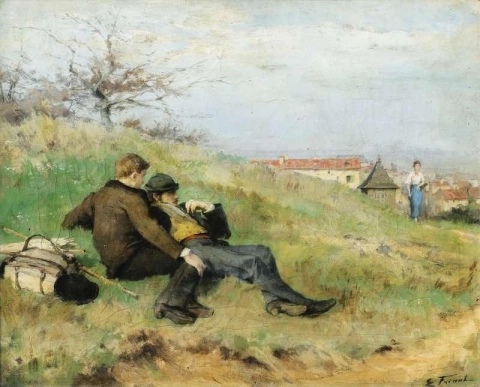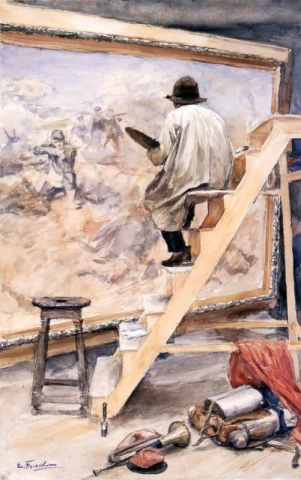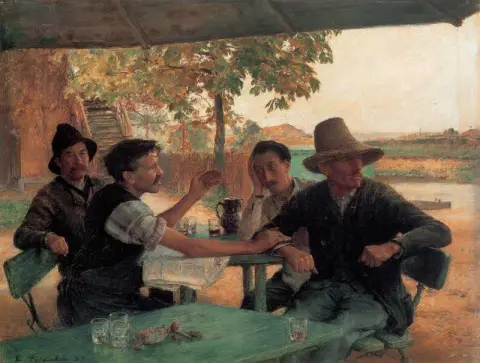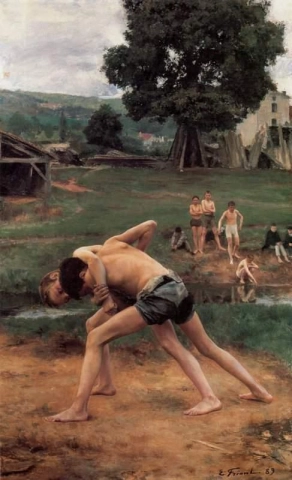

Hand painted reproductions of Emile Friant
Émile Friant: A Master of Naturalism and Emotional Expression in Art
Émile Friant (1863–1932) was a French painter renowned for his remarkable naturalistic style and emotional depth. Known for his ability to capture the human condition with sensitivity and precision, Friant's works offer a vivid portrayal of everyday life, human emotions, and the nuances of light and shadow. His mastery of naturalism and his emphasis on psychological depth positioned him as a significant figure in late 19th and early 20th-century French art.
Early Life and Education
Born in the city of Nancy, France, in 1863, Émile Friant showed an early passion for art. His family supported his artistic ambitions, and at the age of 14, he entered the École des Beaux-Arts in Nancy, where he received formal training in drawing and painting. Friant’s education allowed him to refine his technique and study the works of the great masters, which influenced his approach to realism.
As a young artist, Friant further honed his skills in Paris, where he studied under prominent teachers, including Jean-Léon Gérôme. His exposure to the art scene in Paris exposed him to the academic realism that was prevalent at the time. Friant’s mastery of naturalistic techniques and his ability to depict the complexities of human emotion were developed during these formative years.
Artistic Development and Style
Émile Friant's artistic style is grounded in naturalism, a movement that sought to depict the world in its most truthful and unembellished form. Friant’s commitment to portraying his subjects with meticulous attention to detail is evident in his masterful technique. His works are characterized by a sense of realism that extends beyond mere physical appearance, aiming to capture the inner emotions and psychological depth of his subjects.
Friant's use of light and shadow is one of the defining features of his work. His portraits and genre scenes often demonstrate his ability to create a sense of atmosphere, using light to reveal the subtle emotions of his subjects. He was also adept at portraying textures, from the softness of skin to the rich fabric of clothing, adding a tactile quality to his paintings that made them feel almost lifelike.
In his genre scenes, Friant often depicted moments of daily life, focusing on the quiet, intimate interactions between people. His paintings show an interest in the psychological states of his characters, capturing their inner worlds through subtle gestures, expressions, and postures. The precision in his rendering of detail and his sensitivity to human emotion set him apart from many of his contemporaries.
Themes and Significance
Émile Friant's work often focused on themes of human emotion, social interactions, and the nuances of everyday life. His genre scenes, which often featured quiet moments of domestic life or intimate conversations, revealed a deep understanding of human relationships and psychological depth. Through his portrayal of people in their most natural, unguarded states, Friant captured the complexity of human nature with a sense of tenderness and empathy.
His portraiture also showcased his ability to connect with his subjects on an emotional level. Whether painting a family member, a friend, or a sitter from the French bourgeoisie, Friant’s portraits revealed the personality and emotional state of the individual, capturing the essence of who they were. His use of light and subtle facial expressions gave his portraits a remarkable depth, making each subject feel alive and present.
In addition to his portrait and genre paintings, Friant also created large historical and allegorical works, which were marked by the same attention to emotional detail and naturalistic technique. His ability to combine technical skill with emotional expression made him an influential figure in the French art scene during the late 19th and early 20th centuries.
Achievements and Influence
Émile Friant enjoyed a successful career, exhibiting his works at major salons in France, including the Salon of the Société des Artistes Français, where he earned several awards for his exceptional skill and contributions to the field of naturalism. He was awarded a gold medal at the Salon in 1889, solidifying his reputation as a prominent figure in French art.
His works were highly regarded for their technical precision and emotional depth, and Friant became known for his ability to blend academic realism with a more introspective and emotional portrayal of his subjects. Though he was not as widely known internationally as some of his contemporaries, Friant’s contributions to naturalism were substantial, and his influence can be seen in the works of later artists who sought to capture the psychological and emotional complexity of their subjects.
Friant’s impact was also felt within the French artistic community, where he served as a mentor to younger artists and participated in various art exhibitions. His work was celebrated not only for its technical mastery but also for its profound exploration of human emotion.
Legacy
Émile Friant’s legacy as an artist is one of emotional depth, naturalism, and technical excellence. His ability to capture the quiet moments of everyday life, as well as the psychological complexity of his subjects, set him apart as one of the key figures in the naturalist movement. His works continue to be appreciated for their timeless portrayal of human emotion and the nuances of light and shadow.
Today, Friant’s paintings are held in private collections and museums, where they are admired for their intricate details, emotional resonance, and their lasting contribution to the French tradition of realism. His portraits and genre scenes continue to inspire art lovers and collectors, offering a glimpse into the rich inner lives of his subjects.
Where to Find Reproductions of Émile Friant’s Art
For those wishing to experience the emotional depth and technical mastery of Émile Friant's work, high-quality oil painting reproductions are available. These artworks bring the intimate world of Friant’s portraits and genre scenes into your home, offering a lasting connection to his masterful portrayal of human emotion and naturalism.
Imagine owning an original-style painting by one of the greatest artists in history. At POD, we offer you the chance to make this dream a reality. Each canvas is faithfully reproduced down to the smallest detail, allowing you to experience the beauty of the artist’s vision in your own home.
Our reproductions are crafted by experienced painters using the finest materials and time-honored methods. We are committed to delivering works of exceptional quality that will inspire and bring joy to your family for generations to come.





















































